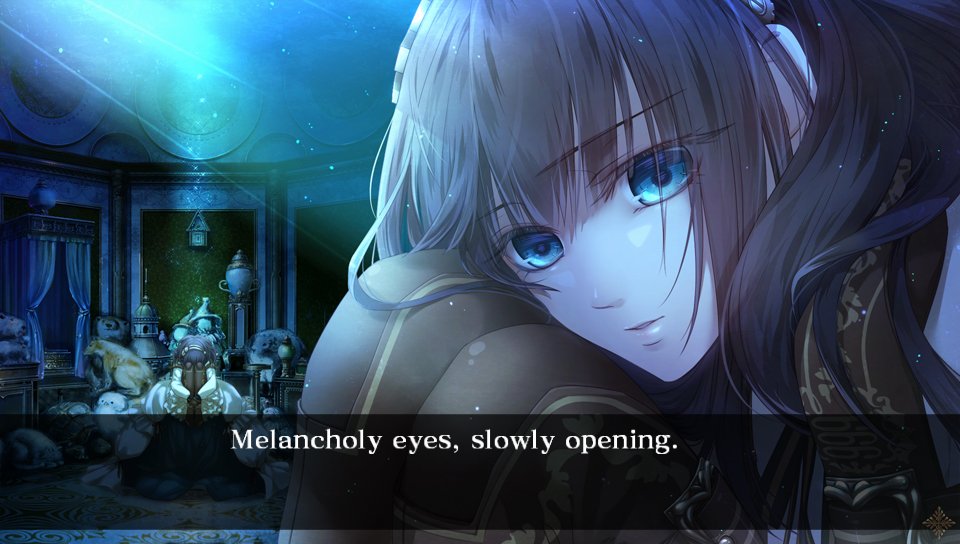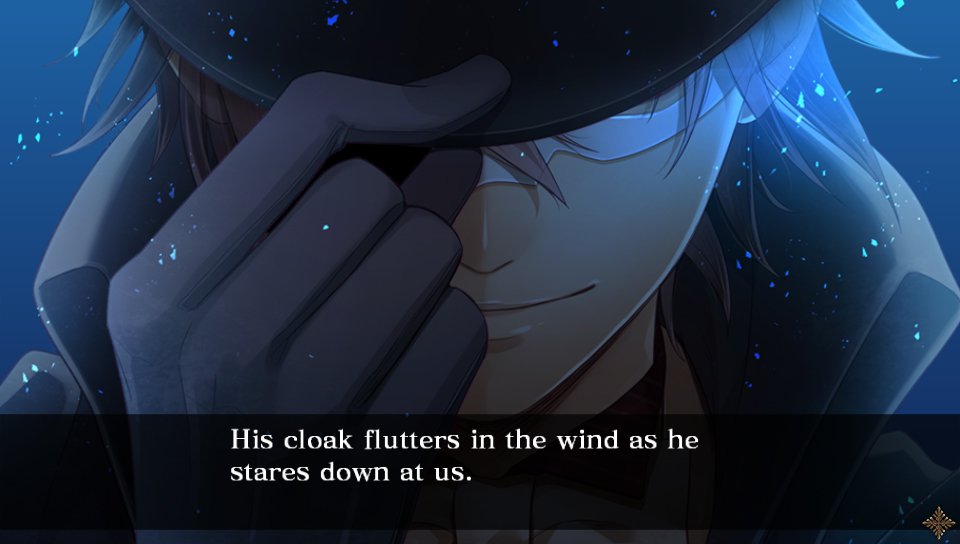Code: Realize is an otome game that loves literature
A few weeks back, I argued that men should play more otome games. And I stand by that statement. In fact, I stand by it so much that I’m taking my own advice: I’m playing more otome games. And I’ve started with Code: Realize, a game I’ve had on my radar since its original Vita localisation in 2015.
I’m less than halfway through at the time of writing, but Code: Realize is, so far, delivering everything that I hoped it would: mystery, intrigue, a fascinating cast of characters, a distinctly adorable heroine — and a pleasingly bonkers premise that the game absolutely commits to and plays admirably, completely straight.

For the unfamiliar, in Code: Realize we follow the story of Cardia, a young woman who awoke alone in a mansion with no memories from longer than two years ago. She has a weird gem in her chest and believes she’s a monster — oh, and her skin is so toxic that it burns and melts anything she touches.
In short order, legendary gentleman thief Arsène Lupin and noted engineer Impey Barbicane rescue her from a kidnapping attempt by Queen Victoria’s Royal Guards, and they take her to their hideout, the mansion of the eccentric philosopher Count Saint-Germain in London. Through various circumstances, Cardia also encounters Victor Frankenstein, an alchemist on the run, and Abraham Van Helsing, a veteran of the Vampire War and a master of rather creative gunplay.
You’ll doubtless notice a few things from that description: firstly, a gleeful commitment to absurdity — a commitment which the game never seems ashamed of, or attempts to “apologise” for with ironic self-referential or self-deprecating humour — and secondly… gosh, that’s a lot of figures drawn from both history and period fiction!
It’s not anything particularly unusual to see a work of Japanese popular fiction draw influences (or outright lift characters) from world mythology and history — Type-Moon’s Fate series has thrived on it for nearly two decades at this point — but there’s something particularly special about Code: Realize in this regard. It becomes very clear that despite the fact this game can be looked upon as a “literature fanservice” visual novel, it has a great deal of respect for its original source material, and makes good use of the characters in a surprisingly plausible way.

Take leading man Arsène Lupin, for example. Looking at things superficially, the depiction of Lupin in Code: Realize is pretty authentic to how he is usually presented in other forms of media: well-dressed, typically wearing a top hat (only outdoors, mind, because this is the 19th century and it is, of course, improper to wear a hat indoors) and often clad in a mask which obscures the upper half of his face.
As an aside, Persona 5 fans will doubtless notice that protagonist Joker from that game bears more than a passing resemblance to typical representations of Lupin and this is, of course, deliberate — Joker’s default Persona is literally a manifestation of Arsène Lupin. Indeed, Arsène Lupin is regarded as the inspiration for the entire “phantom thief” or “kaitou” genre in Japanese popular media, which Persona 5, in turn, draws heavy inspiration from. But I digress.
Code: Realize’s Lupin, in accordance with his original depiction in French author Maurice Leblanc’s stories, is an immaculately mannered individual who never comes across as aloof or superior to anyone else; his politeness has a warmth to it that makes people feel at ease, which makes him an ideal “canonical” love interest for Cardia; Code: Realize’s “true” ending corresponds to Lupin’s narrative route, and can only be explored after you have seen all the other routes through to their respective conclusions.
It goes further than that, though. During a memorable heist sequence in Code: Realize, Lupin comes face-to-face with a rival character called “Herlock Sholmes”, which at first glance you might assume to just be a bad joke. But no; there is actually canonical precedent for this.
In 1906, Leblanc introduced Sir Arthur Conan Doyle’s popular character Sherlock Holmes to the Lupin literary universe, with an aged Holmes meeting a youthful Lupin. Since this was unauthorised use of Doyle’s copyright, Leblanc was forced to change the name of the character when the story was republished in book form. The new name that Leblanc chose for this character was, you guessed it, “Herlock Sholmes”.
Lupin isn’t the only character in Code: Realize to draw extensive influence from literature, though.

The Victor Frankenstein we see in the game is represented as a somewhat youthful figure, and his interest in chemistry and alchemy is very much in keeping with the early life of the Victor Frankenstein from Mary Shelley’s original book. His seeming sense of guilt and unease is also very much in keeping with the original literary Victor Frankenstein, though for different reasons.
The Abraham Van Helsing of Code: Realize, meanwhile, is certainly a man with “an iron nerve, a temper of the ice-brook and indomitable resolution, self-command and toleration exalted from virtues to blessings”, as described by Dr Seward in Bram Stoker’s Dracula. And while the cast’s initial encounters with him might make him out to be a cold, unforgiving character, it doesn’t take long for him to prove himself through his interactions with Cardia as a man with “the kindliest and truest heart that beats”, doing “noble work for mankind, work both in theory and practice, for his views are as wide as his all-embracing sympathy”.
Impey Barbicane might seem at first glance to be the least well-known literary reference of the game, hailing from Jules Verne’s From the Earth to the Moon. But there’s plenty of authenticity even in this character, primarily through his interest in engineering and his desire to go to the moon; the very premise of the book from which he hails is that he’s a weapons enthusiast who believes he can construct a cannon capable of shooting a projectile to the moon.
And even if Impey’s name is unfamiliar, you might be surprised at the influence From the Earth to the Moon has had on popular culture in general; it served as the original inspiration for the Space Mountain rollercoaster at Disneyland Paris, was quoted in Back to the Future Part III and was even referenced by the crew of the Apollo 11 mission on their return from their jaunt to the moon.

In fact, the only character who appears to not quite fit in with all this is the Count of Saint-Germain, who is actually a real-life figure from history. There’s something interesting about him when you consider Code: Realize’s 19th century alternate history setting, however; in the real world, the Count of Saint-Germain has somewhat unclear origins, but was believed to have been born some time between 1691 and 1712, and died on February 27 1784.
This obviously makes him look like something of an anachronistic inclusion in Code: Realize, but it’s all in keeping with the mythology that Saint-Germain seemingly liked to create about himself. He preferred to deflect enquiries about his origins by making ridiculous claims such as the fact that he was five hundred years old, and was dubbed by philosopher Voltaire as “a man who does not die, and who knows everything”.
His inclusion in Code: Realize is fitting, given the story’s exploration of subjects such as alchemy and the belief in immortality. Specifically, numerous myths and legends about Saint-Germain began circulating in the late 19th century, with some groups even going so far as to believe him an immortal, supernatural being, while others believe that he was actually Francis Bacon by birth, and/or the child of Queen Elizabeth and Lord Dudley, and possibly the person who actually wrote the complete works of William Shakespeare.
Saint-Germain is a figure who remains shrouded in a certain amount of mystery so far as the real world is concerned, so it’s fitting that he’s presented as a mysterious but affable eccentric in Code: Realize. Despite not being drawn from established literary canon as the other characters are, his inclusion never feels out of place in the context of the setting and narrative that the visual novel establishes — and I suspect exploring his route will reveal plenty of interesting truths about him.
From all this, hopefully you can see that Code: Realize is a game that, while drawing inspiration from classic works of literature, makes creative use of them to produce something with a distinctive, intelligent feel to it. While there’s no need to do any “background reading” on the various characters in order to enjoy the game — they’re well-established as characters simply within the context of Code: Realize itself — this is most certainly a game that rewards a broad familiarity with the arts.
And that’s just one of many reasons this game is worth your time!
Join The Discussion
Rice Digital Discord
Rice Digital Twitter
Rice Digital Facebook
Or write us a letter for the Rice Digital Friday Letters Page by clicking here!
Disclosure: Some links in this article may be affiliate links, which means we may earn a small commission if you make a purchase after clicking on them. This is at no additional cost to you and helps support Rice Digital!
- Letter from the Editor: passing the torch - June 30, 2023
- Super Woden GP 2 is looking promising - June 30, 2023
- Inti Creates is making a 32 bit-style Love Live action platformer - June 26, 2023






